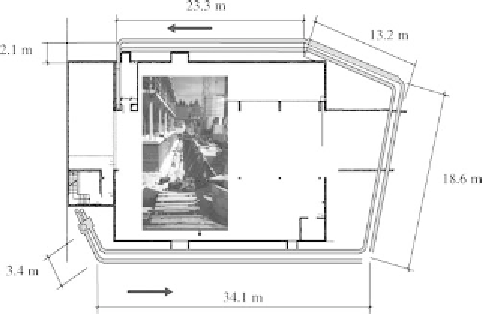Environmental Engineering Reference
In-Depth Information
3.7 years. Thermal interference between two boreholes separated by 5m becomes
relevant for
t>t
s
/
150, that is 0.5 years.
Numerical models offer more flexibility in the temperature field calculation for
arbitrary geometries and time-varying heat fluxes and inlet temperature levels and have
been chosen here for parameter studies. The potentials and limits of direct geothermal
energy use for the heating and cooling of buildings is analysed in the following using
the results of measurements, and simulation studies carried out by the author.
4.1 Earth Heat Exchanger Performance
4.1.1 Earth to Air Heat Exchanger in a Passive Standard Office Building
In the passive standard office building of the Lamparter Company in Weilheim,
Germany, an earth heat exchanger cools the fresh air supplied to the building. It is
positioned around the building and consists of two polyethylene pipes with a diameter
of 0
.
35m and a length of 90 m each. The pipes are laid at a mean depth of 2
.
80 m at a
mutual distance of 0
.
9m (Figure 4.2). By ventilating ambient air through the system,
the air is cooled in summer and heated in winter.
The earth to air heat exchanger of the office building is mainly designed for winter
preheating of ambient air. It reduces the heating demand for fresh air ventilation and
prevents freezing of the cross-flow heat exchanger of the heat recovery system. During
summer the earth to air heat exchanger helps to meet the cooling loads of the building.
A main design goal was to achieve a small pressure loss (Pfafferott, 2003). At the
nominal volume flow of 1900 m
3
h
−
1
and a pressure drop of 175 Pa, an air exchange
rate of 0
.
6h
−
1
is provided.
Figure 4.2
Outline of building with earth heat exchanger

Search WWH ::

Custom Search